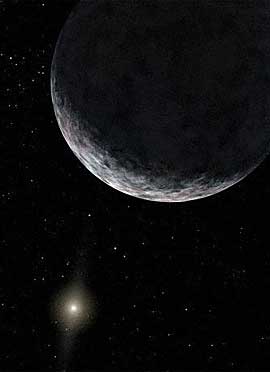Meet Xena, the first new planet to be found in our solar system since Pluto

The planet - a giant lump of rock and ice, more than nine billion miles from the Sun - is the first to be discovered since Pluto in 1930. The breakthrough will cause the redrawing of the maps of our corner of the universe.
"Get out your pens and start rewriting the textbooks today," says an exultant Dr Michael Brown, of the California Institute of Technology, who made the discovery. But even he admits that the new planet - 97 times further from the Sun than Earth, three times even than Pluto - is scarcely a welcoming place, even to aliens.
"If you were sitting on the surface and held a pin at arm's length, you would cover the Sun with the head of the pin," he says. "It's not the sort of place you would want to go on summer vacation."
No, indeed. It is almost unimaginably cold: on a good day, it might touch minus 400F. And you'd be a long time waiting for your annual holiday to come round, as the planet's year is wearyingly long - it takes more than 204,000 days to orbit the sun.
Labelling the holiday snaps, at least at present, would be another problem. For the time being, the planet is officially the unromantic 2003 UB313.
Dr Brown and his team have christened it Xena, after the warrior princess in the old television series, "... because we always wanted to name something Xena". But the formal decision on a name will be made by the International Astronomical Union.
Xena - if such it formally becomes - is the biggest object to have been discovered in the solar system since Neptune in 1845. More important, at about 2,000 miles across, it is considerably bigger than Pluto, which is what gives it the right to be considered our 10th planet.
Since 1992, scientists have discovered that there is a swarm of some 70,000 heavenly bodies buzzing around in the vast distances on the far side of Neptune, in the so-called Kuiper Belt.
Primitive remnants from the birth of the solar system, they are thought to be the parents of the comets that return to our skies most frequently. Chips, struck off when two of the objects collide, are believed to form the nuclei of the ominous visitors.
Pluto is one of them, and five years ago there was an international attempt to strip it of its planetary rank, as - at just 1,450 miles across - it is much smaller than our Moon. But the bid was beaten off under public protest, and since then it has been understood that anything bigger than Pluto would be recognised as a planet too.
Over recent years there have been several near misses. Dr Brown and his team of planet-spotters found one in 2002, and another last year. And only on Thursday astronomers at the Institute of Astrophysics in Andalusia, Spain, announced another - just beating Dr Brown, who had planned to unveil it at a conference in Cambridge in September.
Indeed, Dr Brown rushed out the news of Xena early, after learning that someone "with more cleverness than scruples" had hacked into his restricted website on Thursday night, and fearing that he would be beaten to the announcement.
"We are 100 per cent confident that this is the first object bigger than Pluto ever found in the outer solar system," Dr Brown says.
He and his team first photographed Xena two years ago, without realising what it was. It was only when they snapped it again, and found it had moved, that they realised they had found a planet.
They finally twigged on 8 January this year, just eight days too late for Dr Brown. For five years ago, he bet a fellow astronomer, Sabine Airieau, five bottles of good champagne that he would find the solar system's 10th planet by the end of 2004.
At the end of last year, he ruefully accepted that he had failed and sent off the bottles. But, once Xena was found, he says, Dr Airieau "graciously decided" that he had won a moral victory after all, and agreed to pay up herself.
"That means I get to drink 10 bottles of good champagne," he says. And if that does not put him into orbit, nothing will.
THE SEARCH FOR NEW WORLDS
1930 Pluto, the first planet to be discovered by an American, is found by Clyde Tombaugh. He locates it, serendipitously, while looking for a different planet, "Planet X", which is never found.
2004 Nasa's Hubble Space Telescope detects presence of oxygen and carbon in the atmosphere of HD 209458b, a planet outside our solar system, orbiting a star 150 light-years from Earth.
May 2005 Nasa's Cassini spacecraft confirms suspicions of an unseen moon hidden in Saturn's outer A ring. "Cassini should be the prelude of our future," says team member Dr Andre Brahic.
July 2005 A patch of water ice 35km wide and 2km deep is found on the floor of a crater near the north pole of Mars. Photos are taken by Mars Express, the European Space Agency probe.
Subscribe to Independent Premium to bookmark this article
Want to bookmark your favourite articles and stories to read or reference later? Start your Independent Premium subscription today.

Join our commenting forum
Join thought-provoking conversations, follow other Independent readers and see their replies